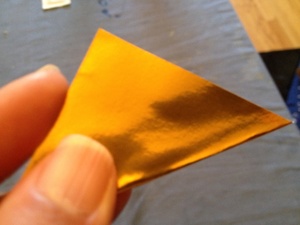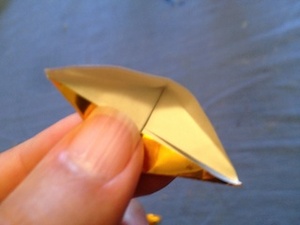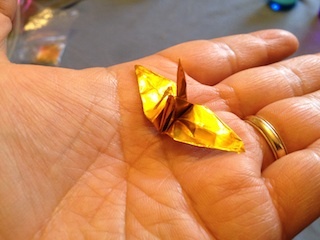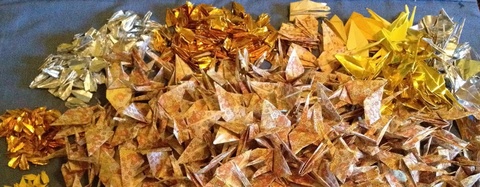“What are those?”
I’m staying overnight with my daughter and her friends on a field trip. My daughter’s best friend is looking at the ziploc bag of paper, sitting on the hotel bedside table.
“They’re origami cranes. You remember the story of Sadako that you read in your class this year? If you fold a thousand, you get a wish?”
“Yeah. Can I look at one?” When I nod she takes one out of the bag, carefully. “They’re cool.”
“I’m trying to fold a thousand for my sister’s wedding. It’s a Japanese American tradition. Cranes are supposed to live a thousand years, and so you fold one for each year.”
She’s still holding one of them in the palm of her hand. “So do you believe in all the legends and myths about the cranes?”
I think hard for a second, feeling my way towards the answer. I’ve never quite thought about it before. “For me, folding cranes is not really about the belief that the wish will come true. But it takes a lot of time and commitment to fold a thousand. If you’re using small pieces of paper, you have to be really patient and careful. I don’t think that if I make a thousand, my sister’s automatically going to have a long and happy marriage. But it’s kind of like prayer, right? It’s a way of showing how much you hope the wish will come true.”
* * * * *
I’m folding a paper square in half diagonally, and half again (triangle, triangle), and then half and half again across the width (rectangle, rectangle). I think about what it means to make a thousand.
I learned how to make a crane in Japan when I was seven, from one of our cousins there. I spoke almost no Japanese; she spoke almost no English. But then she brought out squares of colored paper, and sat at a low table, and we were able to talk somehow. Years later I made hundreds of cranes in college. By the end of my junior year I was able to fold them in the dark, watching a movie during class. The muscle memory stuck. I made a thousand for my own wedding. I start with some of the leftover gold paper that I used for our wedding.
* * * * *
As I’m folding the cranes, I’m thinking about my sister Teruko. My sister cares about handmade objects in her artwork. She’s made hundreds of origami cranes and lilies, ceramic statues, mandalas, prayer flags, and maneki nekos (good luck cats). She believes in handmade objects: ceramics, origami, paintings, sculpture. She believes in touch, in sculpture, in the everyday magic and care that go into creation. Her interest in communication through touch carries over to the rest of her life, where you’ll often find her hugging people to meet them, petting her cats, or touching a stranger lightly on the arm to establish a connection.
While I’m folding, I start to see why Teruko believes in the handmade. To make a crane asks you to work with the paper, patiently and intimately. You have to crease the paper firmly. If you don’t crease firmly, the paper won’t do what you need. What you do to one side, you usually do to the other: there’s a wonderful symmetry in each act. Mistakes can be made easily. If you fold one piece over too far, the wings get stuck and the crane will never emerge. You’re folding the paper so many times that it becomes thick, to become the body of the crane. You make triangles, rectangles, squares, diamonds, even canoes—all in a series of complex steps that’s eventually meant to make the paper fly.
I’m folding yet another set of cranes, waiting to pick up my oldest daughter from school (triangle, triangle). Folding more at night for months before bedtime, while I’m reading a book (rectangle, rectangle). Folding a hundred on the road trip from Seattle to California and back again. Folding another fifty on the family vacation road trip to Cannon Beach. Folding a handful while I’m checking my e-mail, while I’m watching a movie with my daughters. Over months I’m folding, like a pastry chef with cake batter, gently mixing in some of my life, and light, and air.
Handmade is a kind of magic: it carries a person’s touch to another person.
* * * * *
As I’m folding I’m thinking about yellow, one of the colors that my sister’s chosen for her wedding. Yellow is the color of our childhood home. It’s the color of summer sunlight in Northern California. It’s the color that the sunlight made when it came through the shoji screens in our childhood house. Her other color is gray. Yellow and gray, and also gold and silver: colors of things that are meant to last.
I think about our mother and the gift she gave us, the gift of each other (triangle, triangle). I don’t know how she gave us each a sister, when she struggled with her own for so long. But I do know that she gave us each other. She wanted us to be together, to help each other, to talk to each other, to be kind to each other. That’s why I wanted to have two children, not just one. It has been one of the richest relationships of my life.
I think of my sister’s belief in collective efforts: the beauty and power that happens when people come together to work. And so there are cranes in this thousand from our mother, from our auntie (one of our dad’s sisters), and from my oldest daughter: three generations of women coming together to show our hope for my sister’s marriage.
But most of all I think of my sister, and her art. What do you give the beloved little sister who’s getting married, the one who’s been with her love for so long? What do you give the sister whose art is so gorgeous and so brave that you can’t believe she’s your sister? You give her a thousand cranes, senbazuru, and you hope that they give her the energy and inspiration, maybe even the materials, for her next installation.
And so the wedding gift is not just a wish, or a belief; it’s the celebration of a knowing. She and her love know what it is to fold a thousand cranes. They know the repeated, intricate work of turning something that seems ordinary, even flat, into something that can fly.
(For Teruko and Garrett, our love and support always. Love, Sis)
*This article was originally published in Tamiko Nimura, kikugirl on June 8, 2013.
© 2013 Tamiko Nimura









